The very promise to compare rates on hundreds of sites for the same hotel is what makes hotel metasearch inherently flawed.
from HOTELMARKETING.COM https://ift.tt/2yD7u4f
Tuesday, October 30, 2018
Why hotel metasearch is inherently flawed
Sabre’s Q3 bookings swell
Sabre's bookings and revenue each increased 7.7% in the third quarter, prompting the company to increase 2018 guidance for revenue and net income.
from HOTELMARKETING.COM https://ift.tt/2OfnkXJ
Turkish court rejects Booking.com claim
A Turkish court of appeals has rejected a renewed appeal filed by Booking.com against a ban on its activities in Turkey.
from HOTELMARKETING.COM https://ift.tt/2RrdFiS
Chinese business travel spend on the rise
A new report reveals that 45 per cent of Chinese companies expect their business travel spending to increase over the next 12 months.
from HOTELMARKETING.COM https://ift.tt/2PuYK9P
Alipay and the emergence of the “lifestyle super app”
When Alipay talks about the global traveler, travel is not the purpose. The purpose is having fun… so Alipay is trying to enable that.
from HOTELMARKETING.COM https://ift.tt/2RrdAM6
European tech leaders warn against EU digital services tax
Leaders of 16 tech companies including Spotify, Booking.com and Zalando say the proposed tax would undermine the EU's goal of a digital single market.
from HOTELMARKETING.COM https://ift.tt/2PuYHLb
Creative hotel packaging via blockchain
In 2016, Strawberry Group launched eBerry, a separate company with the sole aim of digitalising Norwegian hotel chain Nordic Choice.
from HOTELMARKETING.COM https://ift.tt/2RrdwvQ
Is influencer marketing right for my hotel?
Influencer marketing is all the rage these days but what is it exactly and is it something that your hotel should be doing?
from HOTELMARKETING.COM https://ift.tt/2Jq26pb
Diving Australia’s Hidden Gem: Rowley Shoals
Everyone knows Australia for the iconic Great Barrier Reef. But Western Australia is home to the country’s best-kept diving secret: Rowley Shoals. The shoals have one of the shortest dive seasons running only from September through December, meaning fewer than 200 people dive this isolated and pristine location each year.
Rowley Shoals
The Rowley Shoals Marine Park lies 186 miles (300 km) off Broome, Western Australia. Consequently. it remains one of the most remote and pristine marine environments in the world. The shoals consist of three coral atolls at the edge of the continental shelf. It’s a stunning location for a dive safari, with 360-degree views of turquoise waters and almost no other vessels or people in sight.
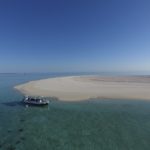
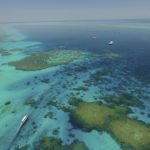
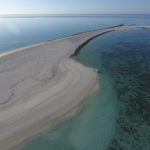
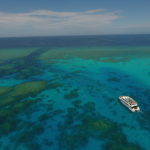
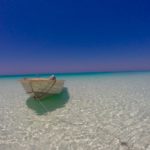
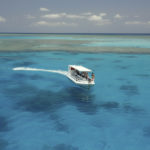
The best Rowley Shoals dive sites
Dives sites at Rowley Shoals offer something for everyone and the diving is suitable for novice and experienced divers. A minimum of 10 to 20 logged dives is usually required.
Rowley Shoals offers pristine coral-reef diving, mostly as wall and drift dives. The best dive areas include:
Mermaid Reef
Northeast of Rowley Shoals, Mermaid Reef is part of the Mermaid Reef National Nature Reserve. It rises from over 1,300 feet (400 m) and features a crystal-clear lagoon surrounded by corals. Sailfish and humpback whales visit the outer sections of the reef and there are numerous corals, giant gorgonian fans, and plenty of fish species about as well. Mermaid Reef has strong tidal flow and currents and features exciting drift dives from outside the atoll into the lagoon.
Vee in the Wall and Odyssey Alley are both on the outer sections and offer fantastic reef- and deep-blue diving. Cod Hole (not to be confused with the dive site of the same name on the Great Barrier Reef) is the place to dive with giant and friendly potato cod. Northern Wall is one of the world’s best dives, featuring a steep drop to 262 feet (80 m), and is home to numerous species of reef fish.
Clerke Reef
Named for Captain Clerke, who first spotted the reef in the 1800s, this reef features a shallow lagoon ideal for snorkeling. There are abundant corals and a variety of marine life. The Aquarium dive site in the lagoon offers easy diving in warm, calm waters.
Clerke Reef also has fantastic wall diving on the outer sections of the reef. Here you’ll find hundreds of fish and coral species as well as gray reef sharks. The visibility often reaches 164 feet (50 m) and divers should keep their eyes peeled for giant clams up to 5 feet (1.5) meters long. Jimmy Goes to China dive site is famous for curious reef sharks and pelagic species cruising along the wall, which is covered in gorgonian fans and black corals.
Rowley Shoals has a wide tidal range, resulting in exciting drift dives. The Rollercoaster is a great example of this and pushes divers through Clerke Reef channel. Fans of adrenaline-filled drift diving will not be disappointed.
Marine-life highlights at Rowley Shoals
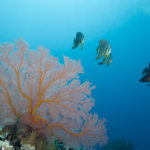
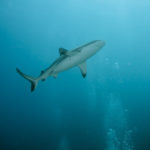
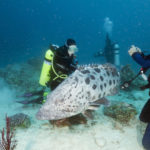
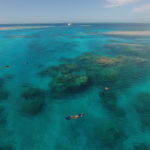
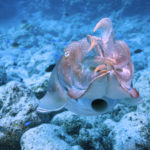
Rowley Shoals is quite biodiverse, with more than 200 species of coral and 700 species of fish, many of which do not live to shore. Residents of the reefs include coral trout, clownfish, humphead parrotfish, Maori wrasse, Spanish mackerel, giant potato cod, dogtooth tuna and green turtles. Divers can swim among schooling trevallies and spot a wide variety of sharks, such as whitetips, blacktips, silvertips and even occasional hammerhead and tiger sharks.
The shoals are not a critter-diving destination as such, but there are plenty of nudibranchs and small stuff to keep fans of small marine life satisfied.
Other area activities
Broome is a popular holiday gateway to the Kimberley region and the area has a variety of highlights, including dinosaur tracks in the rock at Gantheaume Point, the white sands of 13-mile (22 km) Cable Beach and Broome’s famous pearl farms. There are also a handful of Kimberley adventure cruise ships that visit the waterfalls, beaches, gorges and mountains of this wild region.
When to visit
The best time to visit Rowley Shoals is between September and December. Since liveaboard diving is the only way to explore these reefs, early booking is best.
The MV Odyssey and True North liveaboards are the main vessels that visit Rowley Shoals. The MV Odyssey catamaran caters for up to 20 guests and offers 7-night Rowley Shoal safaris.
Getting to Rowley Shoals
Broome is the most common departure point for Rowley Shoals liveaboard safaris. It’s easily accessible via Perth, which has international flight connections from around the world.
Divers and writers at LiveAboard.com contributed this article.
The post Diving Australia’s Hidden Gem: Rowley Shoals appeared first on Scuba Diver Life.
from Scuba Diver Life https://ift.tt/2Suspid
Diving Australia’s Hidden Gem: Rowley Shoals
Everyone knows Australia for the iconic Great Barrier Reef. But Western Australia is home to the country's best-kept diving secret: Rowley Shoals. The shoals have one of the shortest dive seasons running only from September through December, meaning fewer than 200 people dive this isolated and pristine location each year.
Rowley Shoals
The Rowley Shoals Marine Park lies 186 miles (300 km) off Broome, Western Australia. Consequently. it remains one of the most remote and pristine marine environments in the world. The shoals consist of three coral atolls at the edge of the continental shelf. It's a stunning location for a dive safari, with 360-degree views of turquoise waters and almost no other vessels or people in sight.






The best Rowley Shoals dive sites
Dives sites at Rowley Shoals offer something for everyone and the diving is suitable for novice and experienced divers. A minimum of 10 to 20 logged dives is usually required.
Rowley Shoals offers pristine coral-reef diving, mostly as wall and drift dives. The best dive areas include:
Mermaid Reef
Northeast of Rowley Shoals, Mermaid Reef is part of the Mermaid Reef National Nature Reserve. It rises from over 1,300 feet (400 m) and features a crystal-clear lagoon surrounded by corals. Sailfish and humpback whales visit the outer sections of the reef and there are numerous corals, giant gorgonian fans, and plenty of fish species about as well. Mermaid Reef has strong tidal flow and currents and features exciting drift dives from outside the atoll into the lagoon.
Vee in the Wall and Odyssey Alley are both on the outer sections and offer fantastic reef- and deep-blue diving. Cod Hole (not to be confused with the dive site of the same name on the Great Barrier Reef) is the place to dive with giant and friendly potato cod. Northern Wall is one of the world's best dives, featuring a steep drop to 262 feet (80 m), and is home to numerous species of reef fish.
Clerke Reef
Named for Captain Clerke, who first spotted the reef in the 1800s, this reef features a shallow lagoon ideal for snorkeling. There are abundant corals and a variety of marine life. The Aquarium dive site in the lagoon offers easy diving in warm, calm waters.
Clerke Reef also has fantastic wall diving on the outer sections of the reef. Here you'll find hundreds of fish and coral species as well as gray reef sharks. The visibility often reaches 164 feet (50 m) and divers should keep their eyes peeled for giant clams up to 5 feet (1.5) meters long. Jimmy Goes to China dive site is famous for curious reef sharks and pelagic species cruising along the wall, which is covered in gorgonian fans and black corals.
Rowley Shoals has a wide tidal range, resulting in exciting drift dives. The Rollercoaster is a great example of this and pushes divers through Clerke Reef channel. Fans of adrenaline-filled drift diving will not be disappointed.
Marine-life highlights at Rowley Shoals





Rowley Shoals is quite biodiverse, with more than 200 species of coral and 700 species of fish, many of which do not live to shore. Residents of the reefs include coral trout, clownfish, humphead parrotfish, Maori wrasse, Spanish mackerel, giant potato cod, dogtooth tuna and green turtles. Divers can swim among schooling trevallies and spot a wide variety of sharks, such as whitetips, blacktips, silvertips and even occasional hammerhead and tiger sharks.
The shoals are not a critter-diving destination as such, but there are plenty of nudibranchs and small stuff to keep fans of small marine life satisfied.
Other area activities
Broome is a popular holiday gateway to the Kimberley region and the area has a variety of highlights, including dinosaur tracks in the rock at Gantheaume Point, the white sands of 13-mile (22 km) Cable Beach and Broome's famous pearl farms. There are also a handful of Kimberley adventure cruise ships that visit the waterfalls, beaches, gorges and mountains of this wild region.
When to visit
The best time to visit Rowley Shoals is between September and December. Since liveaboard diving is the only way to explore these reefs, early booking is best.
The MV Odyssey and True North liveaboards are the main vessels that visit Rowley Shoals. The MV Odyssey catamaran caters for up to 20 guests and offers 7-night Rowley Shoal safaris.
Getting to Rowley Shoals
Broome is the most common departure point for Rowley Shoals liveaboard safaris. It's easily accessible via Perth, which has international flight connections from around the world.
Divers and writers at LiveAboard.com contributed this article.
The post Diving Australia's Hidden Gem: Rowley Shoals appeared first on Scuba Diver Life.
from Scuba Diver Life https://ift.tt/2Suspid
Monday, October 29, 2018
Google launches new design for hotel search results
After months of testing, Google has released a new design for the hotel search results.
from HOTELMARKETING.COM https://ift.tt/2P0315E
Southeast Asia’s Grab pulls in $200M from Booking Holdings
Southeast Asia's ride-hailing leader Grab is back in the money again after it closed $200 million in fresh capital from Booking Holdings.
from HOTELMARKETING.COM https://ift.tt/2CQ440T
Travelocity launches first augmented reality experience within its mobile app
The AR feature gamifies an experience everyone can relate to: taking vacation photos.
from HOTELMARKETING.COM https://ift.tt/2OXZTHr
Expedia Group’s launches Hotel Guest Insights tool globally
Expedia Group has announced the global launch of Guest Insights, a solutions-driven insights tool for hotels.
from HOTELMARKETING.COM https://ift.tt/2ESphdj
Study reveals how to bridge personalization gap to meet traveler demands
Despite the advancements in digital experiences, many travel brands lack a holistic view of the customer and struggle to accurately personalize their offerings.
from HOTELMARKETING.COM https://ift.tt/2AzJL6w
Social influencer marketing grows following among hotels
In the age of people posting and sharing their lives online, users are more inclined to make travel decisions based on what their friends or followers are posting.
from HOTELMARKETING.COM https://ift.tt/2zb5Fe7
What hoteliers need to know about rate parity
While technology has come a long way to help hoteliers manage today's dynamic distribution landscape, rate parity remains a constant battle for revenue and distribution managers.
from HOTELMARKETING.COM https://ift.tt/2SvcY9h
ASAP partners with ReviewPro
Serviced apartments are gaining ground in the hospitality industry, and the Association of Serviced Apartment Providers (ASAP) aims to provide the assurance consumers need with their Quality Accreditation Process.
from HOTELMARKETING.COM https://ift.tt/2zb5Ea3
Sunday, October 28, 2018
Loyalty programs matter in hotel booking, say business travelers
On average, business travelers consider three hotels before booking and 82 percent say loyalty programs matter when making that decision, according to new research from GBTA.
from HOTELMARKETING.COM https://ift.tt/2Rl3zjh
Travel industry brings innovative technology along for the ride
Room service at the Hotel Monville in Montreal starts with a phone call that tells the guest: Your robot delivery is outside.
from HOTELMARKETING.COM https://ift.tt/2PqFb2E
TripAdvisor ranks “Most Excellent” hotel chains in the world
TripAdvisor announced the "Most Excellent" hotel chains that have the highest percentage of TripAdvisor Certificate of Excellence recipients globally.
from HOTELMARKETING.COM https://ift.tt/2RixuJ1
Hilton CEO speaks to corporate sentiment & rate negotiations
Negotiated corporate business makes up only 10 percent of Hilton's overall business, but CEO Christopher Nassett said the segment serves as a positive macro-indicator for 2019.
from HOTELMARKETING.COM https://ift.tt/2Pr1W6l
Travelers not as loyal as hotels think
More than 80% of people would choose to revoke their personal information from hotel brands if given the opportunity, according to research from Oracle Hospitality.
from HOTELMARKETING.COM https://ift.tt/2SrqWZS
A complete guide to your hotel’s Google My Business profile
Your Google My Business (GMB) profile is an essential piece of your hotel's online marketing channel.
from HOTELMARKETING.COM https://ift.tt/2z9DiwZ
How hoteliers can turn audience insights into a higher conversion rate
Among the many challenges that hoteliers face, being able to quickly amend content on their direct channels ranks high on the list.
from HOTELMARKETING.COM https://ift.tt/2SowVPn
Dublin Skylon Hotel: The strategy that increased revenue by 61%
The Book Direct campaign and message that was created in close consultation with the hotel's team allowed guests to clearly understand the benefits of booking on the hotel's website.
from HOTELMARKETING.COM https://ift.tt/2z84yvS
Wolf Rock: Australia’s Newest Pelagic Dive Site
Right now, everyone's talking about Wolf Rock, a Queensland dive site that's suddenly on plenty of bucket lists. So where is it exactly? And why is Wolf Rock so special?
This rocky pinnacle is a 45-minute boat ride from Rainbow Beach, just north of the Sunshine Coast, halfway between Noosa and Hervey Bay in Queensland.
Alex Heathcote, James Nelson and his partner Fiona Butler have been running Wolf Rock Dive Center for just over two years. In that time, they have revealed a little-known underwater wonder to the world with their amazing videos. Here's what they have to say about what makes Wolf Rock worth diving.
What makes Wolf Rock so special?
Wolf Rock is best known for grey nurse sharks, but we think the sheer diversity of marine life, including many specimens that are so large it blows your mind, makes this a world-class dive spot. The rock formation is also spectacular, which makes the dive even more interesting. Really, it's the consistency of the experience that makes the site a stand out — even on a quiet day it's a good dive.
What are the best times of year to visit?
There's something interesting to see here year-round. The grey nurse sharks are a resident population, but if you want your dive accompanied by whale song, the annual humpback migration comes straight past the dive site between June and October.
What marine life can divers spot at Wolf Rock?
Several different species of sharks and rays consistently visit the site. Grey nurse, leopard, wobbegong and guitar sharks, three species of turtles, eagle and manta rays, pelagic fish (such as barracuda, giant trevally, kingfish, mackerel and cobia), moray eels, nudibranchs, tropical and sub-tropical fish. You name it, you will probably see it here.
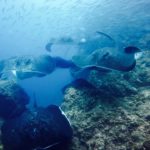
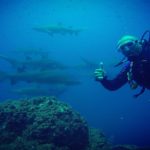
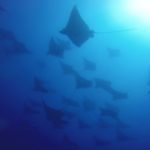
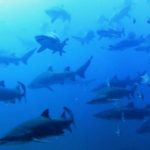
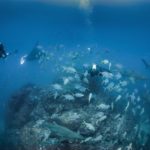
Does any particular dive at Wolf Rock stand out?
We have seen a giant ornate eagle ray, which is like a spotted eagle ray on steroids, on a few dives. They have very distinctive striped markings and are fairly rare. On another recent dive we encountered a mola mola. It's always a treat to see these deep-water fish in the shallows.
Any dive when you see grey nurse sharks, manta rays, eagle rays, bull rays, giant Queensland grouper and loggerhead turtles in the same dive is one to remember, and this experience can be quite common in summer.
I'll never forget one dive when we had about 70 or so grey nurse sharks and four manta rays all mixed in together, with 98-foot (30 m) visibility – that was an outstanding dive. The sharks are mostly about 10 feet (3 m) long and seeing that many large sharks together in such clear water was amazing.
Do people need to be experienced to dive Wolf Rock?
Not necessarily all that experienced but divers do need to have a minimum Open Water Diver qualification and have been diving within the last 12 months. We regularly take open-water divers under our instruction to safely guide them on their first100-foot (30 m) dive with sharks.
Deborah Dickson-Smith is one half of Diveplanit, a dive travel website she manages with her partner Simon Mallender, based in Australia.
The post Wolf Rock: Australia's Newest Pelagic Dive Site appeared first on Scuba Diver Life.
from Scuba Diver Life https://ift.tt/2AwmiTm
Wolf Rock: Australia’s Newest Pelagic Dive Site
Right now, everyone’s talking about Wolf Rock, a Queensland dive site that’s suddenly on plenty of bucket lists. So where is it exactly? And why is Wolf Rock so special?
This rocky pinnacle is a 45-minute boat ride from Rainbow Beach, just north of the Sunshine Coast, halfway between Noosa and Hervey Bay in Queensland.
Alex Heathcote, James Nelson and his partner Fiona Butler have been running Wolf Rock Dive Center for just over two years. In that time, they have revealed a little-known underwater wonder to the world with their amazing videos. Here’s what they have to say about what makes Wolf Rock worth diving.
What makes Wolf Rock so special?
Wolf Rock is best known for grey nurse sharks, but we think the sheer diversity of marine life, including many specimens that are so large it blows your mind, makes this a world-class dive spot. The rock formation is also spectacular, which makes the dive even more interesting. Really, it’s the consistency of the experience that makes the site a stand out — even on a quiet day it’s a good dive.
What are the best times of year to visit?
There’s something interesting to see here year-round. The grey nurse sharks are a resident population, but if you want your dive accompanied by whale song, the annual humpback migration comes straight past the dive site between June and October.
What marine life can divers spot at Wolf Rock?
Several different species of sharks and rays consistently visit the site. Grey nurse, leopard, wobbegong and guitar sharks, three species of turtles, eagle and manta rays, pelagic fish (such as barracuda, giant trevally, kingfish, mackerel and cobia), moray eels, nudibranchs, tropical and sub-tropical fish. You name it, you will probably see it here.





Does any particular dive at Wolf Rock stand out?
We have seen a giant ornate eagle ray, which is like a spotted eagle ray on steroids, on a few dives. They have very distinctive striped markings and are fairly rare. On another recent dive we encountered a mola mola. It’s always a treat to see these deep-water fish in the shallows.
Any dive when you see grey nurse sharks, manta rays, eagle rays, bull rays, giant Queensland grouper and loggerhead turtles in the same dive is one to remember, and this experience can be quite common in summer.
I’ll never forget one dive when we had about 70 or so grey nurse sharks and four manta rays all mixed in together, with 98-foot (30 m) visibility – that was an outstanding dive. The sharks are mostly about 10 feet (3 m) long and seeing that many large sharks together in such clear water was amazing.
Do people need to be experienced to dive Wolf Rock?
Not necessarily all that experienced but divers do need to have a minimum Open Water Diver qualification and have been diving within the last 12 months. We regularly take open-water divers under our instruction to safely guide them on their first100-foot (30 m) dive with sharks.
Deborah Dickson-Smith is one half of Diveplanit, a dive travel website she manages with her partner Simon Mallender, based in Australia.
The post Wolf Rock: Australia’s Newest Pelagic Dive Site appeared first on Scuba Diver Life.
from Scuba Diver Life https://ift.tt/2AwmiTm
Friday, October 26, 2018
Sea Otters in Olympic Coast National Marine Sanctuary
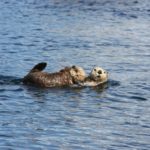
The northern sea otter is the furry ambassador of Olympic Coast National Marine Sanctuary. With their knack for naps and holding hands as they float, their cute faces are pervasive both along the coast and on social media. But it wasn't always this way.
From 1911 to 1969, otters were erased from Washington coastal ecosystems after being hunted during the fur trade. In 1969 and 1970, they were reintroduced to the Olympic Coast when 59 sea otters were flown down from Amchitka, Alaska. Today, 1,800 live along the Olympic coast. As the otters recolonize their former stomping grounds and scope out new territories, NOAA Nancy Foster Scholar Jessica Hale pieces together the past and present by examining otter diet.

Tracking sea otters
A Ph.D. student at the University of Washington, Seattle, Hale spends her summers traversing the Olympic Peninsula. She observes otters feeding in Olympic Coast National Marine Sanctuary. Unlike other marine mammals, otters bring their prey to the surface. Perching on cliffs or sea stacks and armed with a telescope, Hale spies on otters as they forage on crabs, clams, urchins, snails — and sometimes — octopuses. She records data such as how much time they spend collecting prey underwater and resting at the surface. She also records the amount of time it takes them to eat a prey item. Using this information, she wants to understand how otter diet changes over space and time.
"My research is important because sea otters are what's termed a 'keystone species.' This means that marine ecosystems with and without sea otters are really different," Hale explains. "It's either a single species ecosystem versus a really diverse ecosystem that includes sea otters. That's important for me to keep in mind when looking at how reintroduced otters are impacting the sanctuary."
Otters help ecosystems
In a world without otters, sea urchins would decimate kelp forests. Instead of a lush underwater forest, sandy barrens covered in sea urchins would predominate. As a keystone species, sea otters keep urchin populations in check. Kept in balance, the kelp forest ecosystem serves as vital habitat for invertebrate and fish communities, harbors fish nurseries, and protects the coast from waves and storms.
Because otters need to eat 25 percent of their body weight daily, it's important for them to consume food that gives them the most calories possible — high-quality prey. Across the sanctuary, Hale has found that otters at newly established sites are getting more calories per minute from their prey than those at longer established sites, where otters are eating lower quality prey.
Changes in otter diet
To understand how diet changes over time, Hale compares her field observations to those from the 1990s at 10 different sites in the sanctuary. "Preliminary [findings are] showing that at the same locations, they're eating lower quality prey," Hale says. "In general, they were eating clams in the [1990s] and now they're eating mostly snails over the whole coast." The longer a population remains at a site, increased competition between otters can lead to lower abundance of high-quality prey items. Therefore, she's seen diet diversity increase at these sites as otters seek out new food sources.
Hale thinks most of these changes over time and space are driven by otters themselves. "When you think of a buffet and everything's available to you, you're probably going to go for your favorite foods first, before you have to move on," Hale explains.
"It's similar for otters. They'll move into a new area and eat their favorite food first, which mostly happens to be urchins. They're easy to get and have a lot of calories. As otters increase or time [goes on], they'll deplete that prey resource and exhibit this behavior called prey switching. Based on prey abundance, they end up also adding in another type of prey — something like crabs or clams. It keeps going and going until they have really high diet diversity because they're eating whatever they get their hands on, whereas in the beginning they can be choosy."

Competition for food
Otters and people like to eat some of the same food, like Dungeness crab, butter clams, littleneck clams, and red-rock clams. In the southern area of the sanctuary, otters are eating predominantly razor clams. As a result, they're getting more calories than observed anywhere else — 28 kilocalories per minute. To compare, the highest observed anywhere else is 25 kilocalories per minute. It sounds like a small difference, but over the course of a day, that three-kilocalorie window widens into a chasm.
The otters' penchant for razor clams is currently a hot topic. "Because the razor clam fishery didn't do very well this year and sea otters are eating razor clams and have recently occupied that area, I'm giving a talk at the Olympic Coast council meeting to get ahead of this issue," Hale says.
Helping the sanctuary managers balance the ecological contribution of a species with fisheries management may seem like a challenge for some. But it's part of the reason Hale enjoys being involved with the sanctuary.
"The sanctuaries are important for me because they promote research and management through education and outreach," Hale says. "People need to know that sea otters exist for them to care about them, so I rely a lot on the education work that the sanctuary does to instill in people some sense of commitment or caring about the ocean in general. I rely on that as my base for helping people understand my research."
While she completes her Ph.D., Hale will spend summers on the Olympic Coast, tracking the expanding sea otter population. Her research will help Olympic Coast National Marine Sanctuary protect this important species and the kelp forest ecosystem otters maintain.
By guest author Yaamini Venkataraman
Yaamini Venkataraman is a social media intern at the NOAA Office of National Marine Sanctuaries and a graduate student at the University of Washington.
About the Nancy Foster Scholarship program:
NOAA's Dr. Nancy Foster Scholarship Program provides graduate students in oceanography, marine biology, maritime archaeology, and coastal and ocean-resource management with financial support and tools for success inside and outside graduate school. The program seeks to increase the number of women and minorities in these scientific disciplines, particularly as they relate to the mission of the NOAA Office of National Marine Sanctuaries.
The post Sea Otters in Olympic Coast National Marine Sanctuary appeared first on Scuba Diver Life.
from Scuba Diver Life https://ift.tt/2qklag5
Sea Otters in Olympic Coast National Marine Sanctuary

The northern sea otter is the furry ambassador of Olympic Coast National Marine Sanctuary. With their knack for naps and holding hands as they float, their cute faces are pervasive both along the coast and on social media. But it wasn’t always this way.
From 1911 to 1969, otters were erased from Washington coastal ecosystems after being hunted during the fur trade. In 1969 and 1970, they were reintroduced to the Olympic Coast when 59 sea otters were flown down from Amchitka, Alaska. Today, 1,800 live along the Olympic coast. As the otters recolonize their former stomping grounds and scope out new territories, NOAA Nancy Foster Scholar Jessica Hale pieces together the past and present by examining otter diet.

Tracking sea otters
A Ph.D. student at the University of Washington, Seattle, Hale spends her summers traversing the Olympic Peninsula. She observes otters feeding in Olympic Coast National Marine Sanctuary. Unlike other marine mammals, otters bring their prey to the surface. Perching on cliffs or sea stacks and armed with a telescope, Hale spies on otters as they forage on crabs, clams, urchins, snails — and sometimes — octopuses. She records data such as how much time they spend collecting prey underwater and resting at the surface. She also records the amount of time it takes them to eat a prey item. Using this information, she wants to understand how otter diet changes over space and time.
“My research is important because sea otters are what’s termed a ‘keystone species.’ This means that marine ecosystems with and without sea otters are really different,” Hale explains. “It’s either a single species ecosystem versus a really diverse ecosystem that includes sea otters. That’s important for me to keep in mind when looking at how reintroduced otters are impacting the sanctuary.”
Otters help ecosystems
In a world without otters, sea urchins would decimate kelp forests. Instead of a lush underwater forest, sandy barrens covered in sea urchins would predominate. As a keystone species, sea otters keep urchin populations in check. Kept in balance, the kelp forest ecosystem serves as vital habitat for invertebrate and fish communities, harbors fish nurseries, and protects the coast from waves and storms.
Because otters need to eat 25 percent of their body weight daily, it’s important for them to consume food that gives them the most calories possible — high-quality prey. Across the sanctuary, Hale has found that otters at newly established sites are getting more calories per minute from their prey than those at longer established sites, where otters are eating lower quality prey.
Changes in otter diet
To understand how diet changes over time, Hale compares her field observations to those from the 1990s at 10 different sites in the sanctuary. “Preliminary [findings are] showing that at the same locations, they’re eating lower quality prey,” Hale says. “In general, they were eating clams in the [1990s] and now they’re eating mostly snails over the whole coast.” The longer a population remains at a site, increased competition between otters can lead to lower abundance of high-quality prey items. Therefore, she’s seen diet diversity increase at these sites as otters seek out new food sources.
Hale thinks most of these changes over time and space are driven by otters themselves. “When you think of a buffet and everything’s available to you, you’re probably going to go for your favorite foods first, before you have to move on,” Hale explains.
“It’s similar for otters. They’ll move into a new area and eat their favorite food first, which mostly happens to be urchins. They’re easy to get and have a lot of calories. As otters increase or time [goes on], they’ll deplete that prey resource and exhibit this behavior called prey switching. Based on prey abundance, they end up also adding in another type of prey — something like crabs or clams. It keeps going and going until they have really high diet diversity because they’re eating whatever they get their hands on, whereas in the beginning they can be choosy.”

Competition for food
Otters and people like to eat some of the same food, like Dungeness crab, butter clams, littleneck clams, and red-rock clams. In the southern area of the sanctuary, otters are eating predominantly razor clams. As a result, they’re getting more calories than observed anywhere else — 28 kilocalories per minute. To compare, the highest observed anywhere else is 25 kilocalories per minute. It sounds like a small difference, but over the course of a day, that three-kilocalorie window widens into a chasm.
The otters’ penchant for razor clams is currently a hot topic. “Because the razor clam fishery didn’t do very well this year and sea otters are eating razor clams and have recently occupied that area, I’m giving a talk at the Olympic Coast council meeting to get ahead of this issue,” Hale says.
Helping the sanctuary managers balance the ecological contribution of a species with fisheries management may seem like a challenge for some. But it’s part of the reason Hale enjoys being involved with the sanctuary.
“The sanctuaries are important for me because they promote research and management through education and outreach,” Hale says. “People need to know that sea otters exist for them to care about them, so I rely a lot on the education work that the sanctuary does to instill in people some sense of commitment or caring about the ocean in general. I rely on that as my base for helping people understand my research.”
While she completes her Ph.D., Hale will spend summers on the Olympic Coast, tracking the expanding sea otter population. Her research will help Olympic Coast National Marine Sanctuary protect this important species and the kelp forest ecosystem otters maintain.
By guest author Yaamini Venkataraman
Yaamini Venkataraman is a social media intern at the NOAA Office of National Marine Sanctuaries and a graduate student at the University of Washington.
About the Nancy Foster Scholarship program:
NOAA’s Dr. Nancy Foster Scholarship Program provides graduate students in oceanography, marine biology, maritime archaeology, and coastal and ocean-resource management with financial support and tools for success inside and outside graduate school. The program seeks to increase the number of women and minorities in these scientific disciplines, particularly as they relate to the mission of the NOAA Office of National Marine Sanctuaries.
The post Sea Otters in Olympic Coast National Marine Sanctuary appeared first on Scuba Diver Life.
from Scuba Diver Life https://ift.tt/2qklag5
Thursday, October 25, 2018
For independent hotels, relationships with OTAs have never been more tense
More trust has been eroded by shady tactics, from breaking parity to basic, uncoupling of package rates being sold independently to members-only rates.
from HOTELMARKETING.COM https://ift.tt/2D6idI6
Expedia beats profit estimates on soaring travel demand
Expedia Group saw major growth in its vacation rental business HomeAway and higher travel bookings in the third quarter.
from HOTELMARKETING.COM https://ift.tt/2PpEXsr
For independent hotels, relationship with OTAs has never been more tense
More trust has been eroded by shady tactics, from breaking parity to basic, uncoupling of package rates being sold independently to members-only rates.
from HOTELMARKETING.COM https://ift.tt/2PY3ylk
Emergence of ‘urban hotel fees’ propels increase in surcharges
Fees and surcharges at U.S. hotels are expected to increase 8.5% to a record $2.93 billion this year.
from HOTELMARKETING.COM https://ift.tt/2At7NzO
Travelport claims a first in GDS NDC booking
Travelport says it is the first GDS operator to manage the live booking of flights using IATA's New Distribution Capability (NDC) technical standard.
from HOTELMARKETING.COM https://ift.tt/2Q0vS6F
Airbnb threatens Israel’s hotel industry
The Israel Hotel Association blames companies such as Airbnb for recent drop in tourists staying in hotels
from HOTELMARKETING.COM https://ift.tt/2PmGCij
OpenTravel Alliance makes strategic changes
OpenTravel will transition its association management relationship to Hospitality Technology Next Generation (HTNG) at the beginning of the 2019 calendar year.
from HOTELMARKETING.COM https://ift.tt/2JfNAQK
Airbnb details its journey to AI-powered search
Researchers at the company describe how they implemented a sophisticated neural network in Airbnb's web and mobile app to improve the relevance of search results.
from HOTELMARKETING.COM https://ift.tt/2PuHYbb
TravelClick featured as key speaker at 2018 Google Travel Executive Forum
TravelClick, an Amadeus Company, participated as a featured speaker at Google's seventh annual Travel Executive Forum in Dublin, Ireland, which took place on Sept. 19th and 20th.
from HOTELMARKETING.COM https://ift.tt/2JhickU
5 ways to get employees excited about engaging with guests
One of the critical elements that make or break a hotel's guest experience is its staff, and that staff's ability and willingness to go the extra mile for your guests.
from HOTELMARKETING.COM https://ift.tt/2JhSn45
Wednesday, October 24, 2018
Nobody in travel like Netflix
Nobody in the travel sector is delivering personalised content and products for consumers the way Netflix and Amazon do.
from HOTELMARKETING.COM https://ift.tt/2yxioIu
Airbnb can’t go on unregulated - it does too much damage to cities
Barcelona is an extreme case, but certainly the law needs to catch up so Airbnb doesn't price locals out of their community
from HOTELMARKETING.COM https://ift.tt/2RffeAq
No-deal Brexit would halt most UK-Spain flights
The number of flights between the UK and Spain could collapse by 95% if no Brexit deal is agreed.
from HOTELMARKETING.COM https://ift.tt/2OLZMyF
Trivago cuts advertising to return to profitability but revenues and referrals fall
Hotel price comparison website Trivago saw a return to profitability in its third quarter although overall revenues and leads passed on to partners were down.
from HOTELMARKETING.COM https://ift.tt/2R899FM
Americans love travel agents and want them on their smartphone
According to Travelport data, 11.2 percent of consumers booked their airline tickets through a travel agency offline in the last 12 months.
from HOTELMARKETING.COM https://ift.tt/2OLZIPr
Google lets users delete search data & control ad settings from Google Search page
Users no longer have to go to their Google Account page to access privacy controls.
from HOTELMARKETING.COM https://ift.tt/2RfeZFw
8 ways to gain more bookings through destination information
Should your hotel website have a section dedicated to area information, or is it even worth competing with other sites who may already have that content?
from HOTELMARKETING.COM https://ift.tt/2CDUazi
How HD Hotels optimized guest surveys to boost TripAdvisor reviews
Convincing guests to open, read and take action on email survey requests is vital to increasing completion rates.
from HOTELMARKETING.COM https://ift.tt/2Pmea0b
Admiral in Strathcona
The Admiral in Strathcona by CH (East Georgia) Limited Partnership is a new four-storey, mixed used development located in the Vancouver neighbourhood of Kiwassa East. Designed with families in mind, this project includes 30 strata townhomes, 7 social housing units, 16,145 SQFT of commercial space and over 6,000 SQFT of amenity space. The Admiral aims to address Vancouver need for housing diversity, while being retaining industrial space for local employment opportunities. This project offers stellar location, located at Glen Drive and East Georgia street, just steps away from schools, parks, restaurants, and East Van craft breweries.
The post Admiral in Strathcona appeared first on Vancouver New Condos.
from Projects – Vancouver New Condos https://ift.tt/2RbJ5cN
Admiral in Strathcona
The Admiral in Strathcona by CH (East Georgia) Limited Partnership is a new four-storey, mixed used development located in the Vancouver neighbourhood of Kiwassa East. Designed with families in mind, this project includes 30 strata townhomes, 7 social housing units, 16,145 SQFT of commercial space and over 6,000 SQFT of amenity space. The Admiral aims to address Vancouver need for housing diversity, while being retaining industrial space for local employment opportunities. This project offers stellar location, located at Glen Drive and East Georgia street, just steps away from schools, parks, restaurants, and East Van craft breweries.
The post Admiral in Strathcona appeared first on Vancouver New Condos.
from Projects – Vancouver New Condos https://ift.tt/2RbJ5cN
Cambridge Estates Fort St. John
Cambridge Estates by Western Canadian Properties Group is a brand new subdivision offering 95 townhouses and 7 coach homes in Fort St. John's premier neighbourhood of Garrison Landing. These homes include contemporary living spaces and fenced yards with complete turn-key rental management options. This project offers easy access to downtown with less than a five minute drive to entertainment, shopping, schools, and hospitals. Experience contemporary living while being steps away from the great outdoors.
The post Cambridge Estates Fort St. John appeared first on Vancouver New Condos.
from Projects – Vancouver New Condos https://ift.tt/2D2YlWo
Cambridge Estates Fort St. John
Cambridge Estates by Western Canadian Properties Group is a brand new subdivision offering 95 townhouses and 7 coach homes in Fort St. John’s premier neighbourhood of Garrison Landing. These homes include contemporary living spaces and fenced yards with complete turn-key rental management options. This project offers easy access to downtown with less than a five minute drive to entertainment, shopping, schools, and hospitals. Experience contemporary living while being steps away from the great outdoors.
The post Cambridge Estates Fort St. John appeared first on Vancouver New Condos.
from Projects – Vancouver New Condos https://ift.tt/2D2YlWo
Diving Munda Wrecks and Reefs
What do you like to see when you dive? Big stuff? Macro? Pretty reefs? Or is it wrecks? Before I visited Munda in the Solomon Islands, I would not have called myself a wreck diver. I think of wrecks as dark, rusting constructions devoid of life. They're interesting to history buffs or divers who like to push limits — or so I thought. Diving Munda wrecks and reefs changed these preconceptions.
Like much of the Solomon Islands, Munda is a tropical paradise; a lush, green island surrounded by turquoise lagoons and coral reefs. But the legacy of WWII is never far away, present above and below water, and perhaps no more so than in Munda. Here there are reefs and wrecks. And the wrecks, just like the reefs, are teeming with life.
Diving Munda wrecks and reefs
I came to the Solomon Islands for its incredible marine biodiversity. I've dived here before and had a small taste of its busy coral reefs, which left me hungry for more.
The Solomon Islands sit on the eastern edge of the Coral Triangle, the global epicenter of marine biodiversity. This area spans over 2.3 million square miles (6 million square km), encompassing Indonesia, Malaysia, the Philippines, Timor and Papua New Guinea. An astonishing 76 percent of the world's coral species live here, along with six of the world's seven turtle species and over 2,228 species of fish.
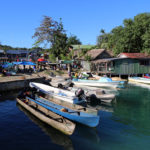
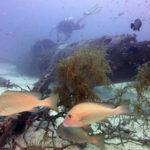
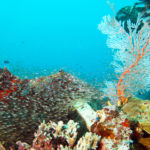
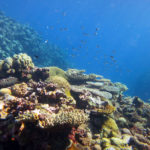
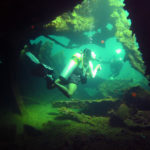
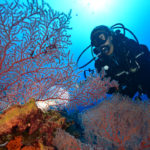
On my first plunge into Rendova Lagoon it seems like they're all here right now in Munda. I don't know where to look first.
The reef wall at Shark Point, our first dive, is covered in corals of all shapes, sizes and colors. Soft corals, whips and sea fans make way for hard, branching corals and moon-shaped brain corals. Flitting among them are thousands of butterflyfish, damsels, angels, anthias and surgeons. Anemones stand by with their resident anemone fish on guard. Out in the blue big schools of snapper, bluefin trevally and barracuda circle.
Our second dive at nearby Munda Reef offers a similar scene. This time a few reef sharks also join us along with some blue-spotted rays. Huge schools of scissortails and fusiliers whoosh past between us.
Wreck diving in Munda
If it were up to me, I'd come back to these same two dive sites every day for the duration of our stay, but our guides from Dive Munda have different ideas.
First, we visit Haipi Reef, about a 30-minute boat ride away. The variety of corals here equals the variety of reef fish. A few humphead parrotfish join us for the dive and we share our safety stop with huge schools of butterflyfish and damsels.
When we surface, our guides tell us our next two dives are wrecks. I'm not thrilled, but since I've enjoyed every dive so far, I'm not expecting to be disappointed. It's these two dives that change my mind about wrecks.
The wrecks are both American fighter aircraft, the first a Bell P-39 Airacobra. This was one of the principal American fighter craft in service when the United States entered WWII.
It's sitting on a white, sandy bottom and it's mostly intact. But that's not the first thing I notice — what I notice first is that I almost can't see it for all the fish.
Large schools of juvenile fish surround the plane, and when I get close enough, I see it's full of them as well, along with hundreds of colorful shrimp. The body of the plane, what I assume was once painted a drab gray, is now painted in colorful corals which create gorgeous patterns along the length of the plane.
The second wreck is the Douglas SBD Dauntless, sitting on a sandy bottom in very shallow water. Soft and hard corals, teeming with life, cover the wreckage. And this one has an interesting story.
Our dive guide tells us that he once took a retired American pilot diving here, the very same pilot who was flying the plane when it was shot down. Even more remarkable is that a short time later, the guide took a Japanese man diving here as well, one who claimed to have shot down the plane during the war.
According to our guide, the pair met up back in Honiara and have remained in touch. While I'm not sure how much of the tale is true, I began thinking about the stories and people behind the many other wrecks in the Solomon Islands. And, as a once disinterested wreck diver, Munda made a believer of me.
As of June 1, 2018, Solomon Airlines is offering non-stop roundtrip flights from Brisbane directly to Munda, making arrival and departure that much easier. Check the website for details.
The post Diving Munda Wrecks and Reefs appeared first on Scuba Diver Life.
from Scuba Diver Life https://ift.tt/2CZJxbf